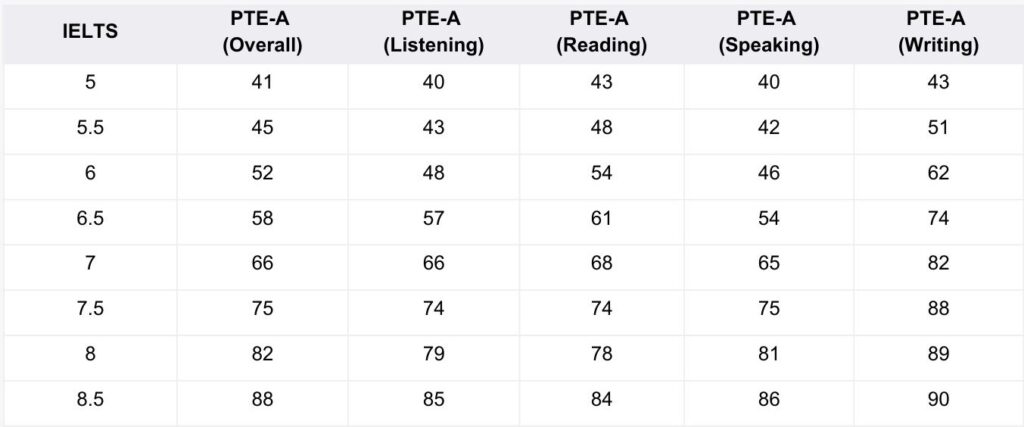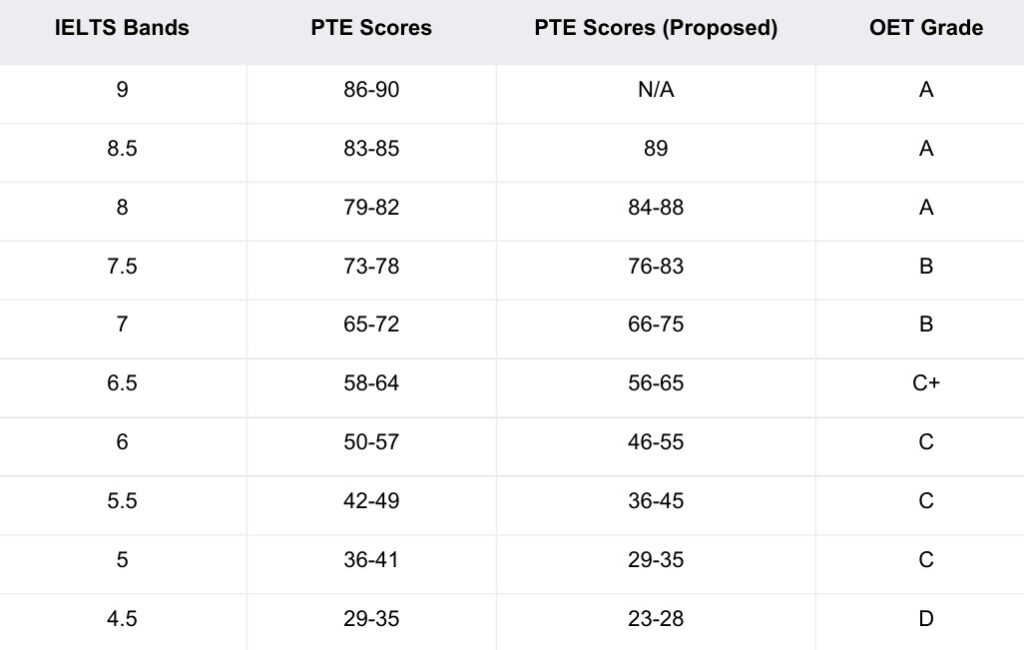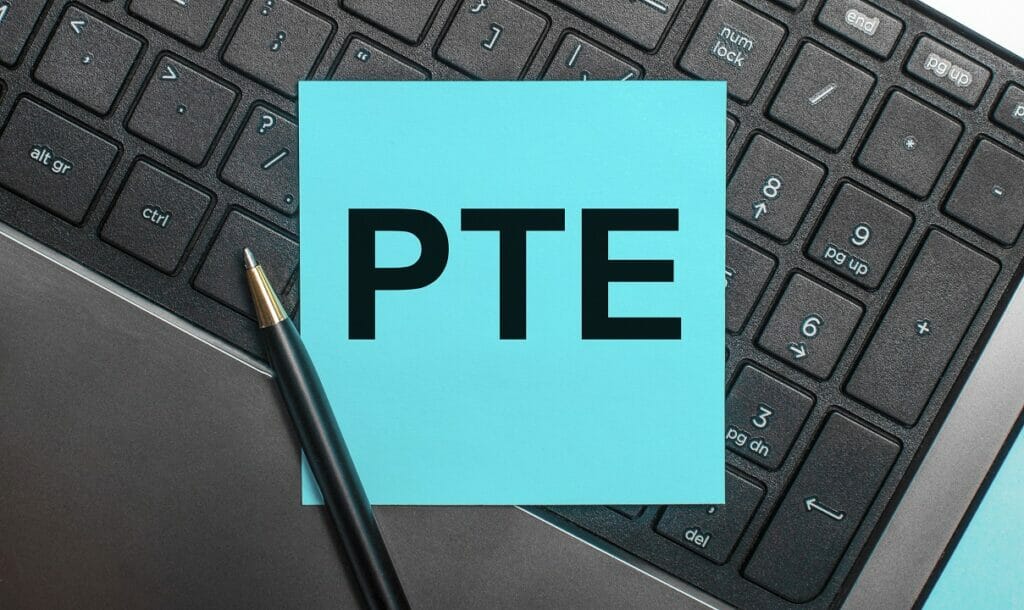A common dilemma for Indian students moving to study abroad is which English proficiency test they should take. With strong contenders like IELTS, PTE, and TOEFL, it’s undoubtedly a tough call!
With over 5 million students appearing for IELTS tests every year and PTE rising in popularity with 1 million tests taken annually, it’s no surprise that questions like “How can I convert my PTE scores to IELTS?” or “Which test is better for me?” may arise frequently.

80+ Practice Questions for all sections
Instant AI Scoring
Detailed Score Improvement Report
Recorded Video Lessons
So, how do you decide between PTE and IELTS, and what if you’ve already taken one and need to convert your scores? Many factors come into play. While some students look for the simplest option, others are more concerned with the format, turnaround time, and university acceptance.
The good news is that regardless of the test you choose among the two, you can convert PTE scores to IELTS band scores! We’re here to explain just how you can do that.
In this blog, we’ll walk you through the PTE to IELTS conversion process, helping you make an informed decision for your academic journey.
Why PTE to IELTS Score Conversion?
A comparison between IELTS and PTE allows you to understand how your scores align. IELTS band scores have become a standard way of defining English proficiency. Many universities ask for IELTS scores over other English proficiency tests.
Some universities accept converted scores, meaning if you have taken the PTE and need to know how your scores fit into the IELTS system, you can use the following PTE score chart in bands.
For example, a 6.5 IELTS band score that is equal to 59 on a Pearson scale reflects the fact that the student understands English well but still needs some more practice and polishing to achieve higher proficiency levels.
Want to know what each band means? Here’s a simplified table of PTE to IELTS score conversion.
| PTE Academic | IELTS | Band Description |
|---|---|---|
| 40.8 | 5.0 | Modest User |
| 45.4 | 5.5 | Modest User |
| 51.6 | 6.0 | Competent User |
| 58.5 | 6.5 | Competent User |
| 66.3 | 7.0 | Good User |
| 74.6 | 7.5 | Good User |
| 82.3 | 8.0 | Very Good User |
| 88.1 | 8.5 | Very Good User |
Note: Exact scores may vary because scoring patterns are different. However, this chart is a close approximation.
Read More:
PTE vs IELTS: Key Differences in 2025
When deciding between IELTS and PTE, it is important to know the differences to determine the most suitable test that best suits your goals.
IELTS and PTE are trusted English proficiency tests for immigration, study or work purposes. These tests are widely accepted by universities worldwide, in countries such as the US, UK, Canada, Australia, Ireland and more, making them two popular options for you. However, there are some key differences between the two.
Here is a quick comparison of the two tests to help you build a foundational understanding.
| Aspect | IELTS | PTE Academic |
|---|---|---|
| Formats | Computer-delivered and Paper-based | Computer-based |
| Purpose | Offers both Academic and General Training modules for study, work, or migration purposes. | Primarily focused on academic purposes but can also be used for general purposes. |
| Duration | 2 hours 45 minutes | 2 hours 15 minutes |
| Exam fee | INR 17,000 | INR 17,000 |
| Result declaration | 2 days(Computer-delivered)13 days(Paper-based) | 2- 5 working days |
| Scoring range | Band score (0-9) | Score (10-90) |
| Minimum Average Score for Universities | 5.5- 6.0+ | 70+ |
Read More:

Excel in IELTS with India’s Top Online Coaching
Leap has helped more than 1 Lakh students achieve 7+ IELTS band.
Official Concordance Table between IELTS and PTE
The official concordance table helps test takers, educational institutions, and employers understand the PTE to IELTS equivalencies between the two testing systems and is updated periodically based on new research and testing data.
Its main purpose is to ensure that all individuals are assessed equitably regardless of which test they choose to take through a fair assessment process.
The table below provides the standardised reference for PTE to IELTS score comparison.

Read More:

Excel in IELTS with India’s Top Online Coaching
Leap has helped more than 1 Lakh students achieve 7+ IELTS band.
PTE Score in Bands
Recently, Pearson released a new report comparing PTE-A scores to IELTS Band scores. It indicates that PTE-A test-takers aiming for an IELTS band of 7 to 9 will require higher scores to achieve equivalence.
Although this report has not been adopted by immigration authorities in Australia and New Zealand, it is recommended to consider these new score requirements based on the PTE to IELTS score calculator when preparing for the PTE Academic test. The details are provided below.
PTE Score Chart 2025

Read More:
How to Prepare for PTE to get the desired result?
Taking the PTE requires a strategic approach to achieve the desired results. Here are some tips that’ll help you prepare for the PTE test effectively:
- Know the test format: Familiarise yourself with the PTE structure. It comprises 4 sections: Speaking, Writing, Reading, and Listening.
- Improve typing speed: PTE is entirely computer-based, which adds the necessity of fast and accurate typing in the writing section.
- Enhance speaking skills: PTE evaluates pronunciation and fluency through automated scoring. Regularly practising with speech recognition tools will help improve your PTE score.
- Improve time management: PTE has a strict time limit for each section. Practising timers helps complete all tasks efficiently, especially in integrated tasks that combine multiple skills.
- Develop strong vocabulary and grammar: A good grasp of English grammar and vocabulary is crucial to improve your performance in all sections.
- Use official practice materials: Use Pearson’s official practice tests to get used to the question types and time limits.
Read More:
How Can LeapScholar Help You?
Making a decision between PTE and IELTS can be difficult. As you weigh your options, consider enhancing your preparation with expert guidance.
LeapScholar IELTS trainers can provide personalised coaching, feedback, and guidance to help you improve your skills and meet your target score. Join the Leap Scholar coaching classes today trusted by thousands of students.
Frequently Asked Questions
-
Q. Is 50 in PTE equal to 6 in IELTS?
Ans. Yes, a PTE score of 50 is approximately equivalent to 6.0 in IELTS. However, it may vary depending on the institution or organisation. Always check the score requirements of the university or another immigration body you’re applying to.
-
Q. What is a PTE 43 score?
Ans. A PTE score of 43 is roughly equivalent to an IELTS band score of 5.0. This reflects a moderate level of English ability, suitable for basic communication and certain academic or professional purposes. However, there may be different score requirements in different institutions.
-
Q. What is PTE equivalent to 7 IELTS?
Ans. A score of 7.0 in IELTS is roughly equivalent to a PTE Academic score of around 65. However, you must check on the specific requirements for the institution or visa category you are applying for. It is always best to check the official PTE to IELTS conversion chart provided by Pearson or the organisation you are applying to.
-
Q. How much is 6 each in IELTS?
Ans. Getting a ‘6 each’ in IELTS means a score of at least 6.0 across the four sections: Listening, Reading, Writing and Speaking. It is a common requirement for student visas and some immigration pathways in countries like Australia, Canada, and the UK.
-
Q. What is 70 PTE score in IELTS?
Ans. A score of 70 in PTE is approximately equivalent to a band score of 7.5 in IELTS. However, some institutions may have specific PTE to IELTS conversion criteria, so it is advisable to refer to official sources for accurate comparisons.
-
Q. How much is 54 PTE in IELTS?
Ans. A score of 54 in PTE Academic is roughly equivalent to a band score of 6.0 in IELTS. This is an acceptable level for most student visas and some work permits, depending on the country and institution.
-
Q. Can I get 8 each in PTE?
Ans. Yes, achieving 8 in each PTE component is possible, that is, at least a 79 mark in Listening, Reading, Writing, and Speaking. In IELTS, this is the same as an 8.0 band score and one of the requirements for skilled migration and professional registration.
-
Q. Which country accepts 6 bands in PTE?
Ans. Countries like the UK, Australia, Canada, and New Zealand accept a PTE equivalent of 6.0 bands for student visas and some work purposes. But there could be different minimum requirements for specific universities and visa types.
-
Q. How long is PTE valid for?
Ans. PTE Academic scores remain valid for two years from the test date. However, for some organisations such as Australian Immigration, if the applicant had met the visa criteria, the scores expired after 2 years may be accepted.
-
Q. Is PTE accepted in Australia?
Ans. Yes, PTE is widely accepted for student visas, skilled migration, and professional registration in Australia. It is accepted by the Australian government, universities, and various professional bodies as a valid English proficiency test.
-
Q. How do PTE vs IELTS scores compare?
Ans. PTE and IELTS scores use different scoring systems, but a broad comparison can be made. For instance, an IELTS 6.5 is approximately equal to a PTE 58, and an IELTS 7.0 is around PTE 65. The choice you make depends on test format preference as well as the requirements of the institution or immigration.

 80+ Practice Questions for all sections
80+ Practice Questions for all sections













Have Questions? Get Guidance to reach your Dream University
Connect with India's finest counsellors and biggest study abroad community.
Get Guidance